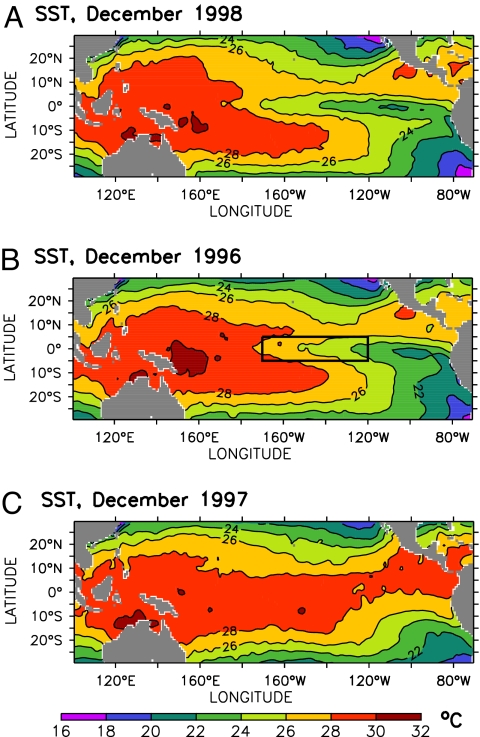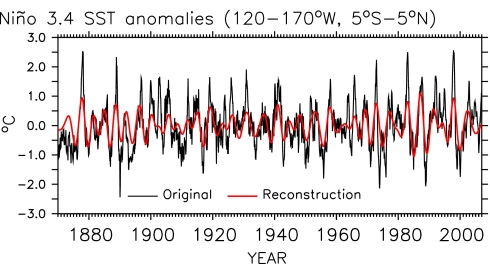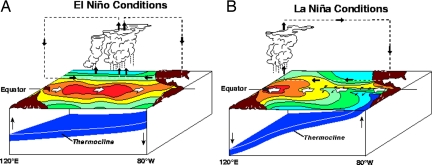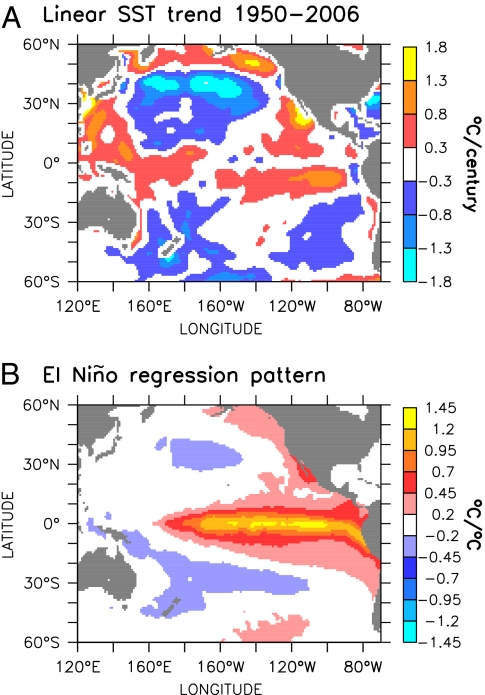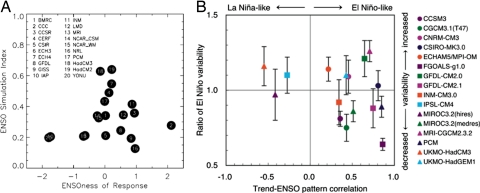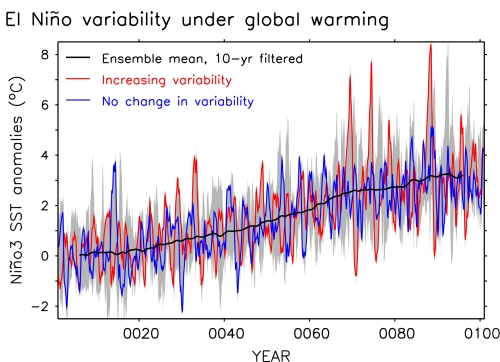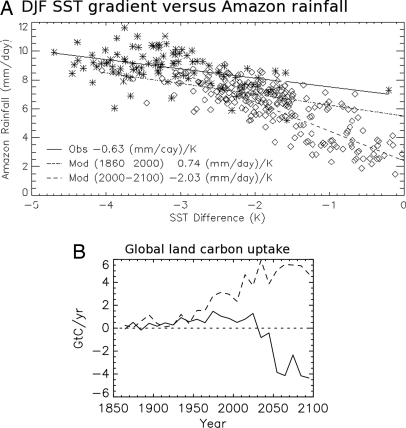Abstract
The El Niño/Southern Oscillation (ENSO) phenomenon, originating in the Tropical Pacific, is the strongest natural interannual climate signal and has widespread effects on the global climate system and the ecology of the Tropical Pacific. Any strong change in ENSO statistics will therefore have serious climatic and ecological consequences. Most global climate models do simulate ENSO, although large biases exist with respect to its characteristics. The ENSO response to global warming differs strongly from model to model and is thus highly uncertain. Some models simulate an increase in ENSO amplitude, others a decrease, and others virtually no change. Extremely strong changes constituting tipping point behavior are not simulated by any of the models. Nevertheless, some interesting changes in ENSO dynamics can be inferred from observations and model integrations. Although no tipping point behavior is envisaged in the physical climate system, smooth transitions in it may give rise to tipping point behavior in the biological, chemical, and even socioeconomic systems. For example, the simulated weakening of the Pacific zonal sea surface temperature gradient in the Hadley Centre model (with dynamic vegetation included) caused rapid Amazon forest die-back in the mid-twenty-first century, which in turn drove a nonlinear increase in atmospheric CO2, accelerating global warming.
One of the main characteristics of the earth's climate is its strong natural variability on a wide range of timescales from seasonal to millennial. Climate variability can be generated, on the one hand, internally through interactions within and between the different climate subsystems (atmosphere, ocean, land, sea ice, glaciers, biogeochemistry). The internal nonlinear (chaotic) dynamics of the atmosphere and the oceans, for instance, and ocean–atmosphere interactions generate a large amount of variability on seasonal to decadal timescales. However, the climate system can be externally forced. The annual cycle is a prominent example. On the very long millennial timescales, changes in the orbital parameters are the most important drivers of climate change. They are the pacemakers of the ice age cycles. Anthropogenic climate change is also considered as externally driven in this context.
El Niño/Southern Oscillation
The El Niño/Southern Oscillation (ENSO) phenomenon is the strongest internal climate mode on interannual timescales. ENSO is characterized by strong excursions of the eastern and central equatorial Pacific sea surface temperature (Figs. 1 and 2) that reoccur on average every four years. The warm extreme is termed El Niño and the cold, La Niña. Although ENSO originates in the Tropical Pacific, it affects not only regional but also global climate. The record El Niño of 1997/1998, for instance, strongly contributed to the record in globally averaged surface temperature in 1998. Furthermore, El Niño has strong impacts on the ecology of the Tropical Pacific and affects the economies of several countries adjacent to the Pacific. Countries on the western side of South America, like Peru and Chile, experience unusually heavy rainfall during El Niño, whereas, on the other side of the Pacific, parts of Australia and Indonesia suffer from severe drought. Even North America is strongly affected by ENSO. Southern California, for instance, receives much more rain during El Niño phases, but the number of frost days is enhanced in Florida, and North Atlantic hurricane activity is suppressed. La Niña and its impacts can be regarded as a mirror image of El Niño. It should be noted that the above is a statistical picture, and that impacts of ENSO vary; for example, Eastern Australia did not experience severe drought during the 1997/1998 record El Niño. The reader is referred to the textbook of Philander (1) and the Special Issue of the Journal of Geophysical Research published in 1998 (2) for further details on ENSO.
Fig. 1.
Sea surface temperature (SST) for typical La Niña (A), normal (B), and El Niño (C) conditions. Data are HadISST 1.1 (41). The black box in B denotes the Niño3.4 region.
Fig. 2.
SST anomalies averaged over the Niño3.4 region (see Fig. 1) and those of the reconstructed ENSO mode, which explains 35% of the total variance. SST in this region is key for large-scale ocean–atmosphere interactions important to ENSO. The reconstructed ENSO mode is determined from Singular Spectrum Analysis. Data are HadISST 1.1 (41).
The mean state of the equatorial Pacific is strongly zonally asymmetric. Sea surface temperature (SST) along the Pacific equator, for instance, exhibits a strong zonal gradient of ≈10° (Fig. 1B) that drives a thermodynamically direct atmospheric circulation cell, the Walker Circulation, in the vertical plane parallel to the equator. The Walker Circulation is associated with westward winds near the surface, piling up warm surface waters in the west, where we observe a deep layer of warm water, the western Pacific “Warm Pool.” The heating of air masses in this region causes them to rise, leading to deep convection and strong rainfall. This is the upward branch of the Walker Circulation. The flow is eastward at upper levels and there is subsidence over the cold eastern equatorial Pacific, completing the circulation cell. We note that the westward surface wind component of Walker Circulation strengthens the Trade Winds associated with the Hadley Circulation, so that the mean state in the Equatorial Pacific can be only understood in terms of large-scale ocean–atmosphere interactions.
The piling up of warm water in the western Equatorial Pacific by the westward Trade Winds causes sea level there to be ≈20 cm higher than in the east. The strong stratification in the ocean requires that the thermocline, the boundary between the warm surface and cold subsurface waters, tilt upward toward the east, to balance the surface westward winds. This makes SST sensitive to vertical thermocline movements in the central and eastern Equatorial Pacific, but more or less insensitive in the west. Furthermore, the effects of the earth's rotation dictate divergent surface currents and thus upwelling of cold water from subsurface levels at the equator in response to the westward winds. The combination of equatorial upwelling and shallow thermocline leads to the rather cold temperatures in the east and the marked SST gradient along the equator (Fig. 1B).
ENSO extremes are associated with changes in the zonal SST gradient. La Niña is characterized by a strong and El Niño by a weak, zonal SST gradient (Fig. 1 A and C). The two extremes tend to occur alternately, and hence describe an oscillation. ENSO's oscillatory nature can be seen from anomalous central equatorial Pacific SST averaged over the Niño3.4 region (Fig. 2; see box in Fig. 1B). A clear, but relatively broad, spectral peak can be detected at a period of ≈4 years (not shown), as visualized by the leading mode reconstruction of the Niño3.4 SST anomaly index (red curve in Fig. 2). The leading (oscillatory) temporal mode was derived from Singular Spectrum Analysis (SSA). It describes ENSO and accounts for ≈35% of the variance in the original time series.
The interplay between SST, the Walker Circulation, and thermocline depth is responsible for the development of the two ENSO extremes. This interplay constitutes a positive feedback, the Bjerknes feedback, which underlies the rapid growth of initial perturbations. Suppose, for instance, a random perturbation enhances eastern equatorial Pacific SST. This anomaly reduces the zonal SST gradient across the Pacific. The anomalously warm SST in the east reduces the surface pressure, weakening the gradient in surface pressure across the Pacific, and eventually reducing the zonal wind stress at the equator and thus the Walker Circulation. The reduced surface wind stress reduces the thermocline tilt, making upwelling of cold waters in the east less efficient, which in turn enhances the initial positive SST anomaly. This further weakens the SST gradient and the chain of events repeats and an El Niño develops (Fig. 3A). Nonlinear feedbacks such as the cloud-albedo or thermocline-SST feedback eventually limit the growth. La Niña events develop in a similar manner, but with the signs reversed (Fig. 3B). The feedbacks may change in response to global warming as the mean state changes, and this can lead to rather different ENSO dynamics.
Fig. 3.
Schematic description of large-scale ocean–atmosphere interactions during the development of ENSO extremes (A, El Niño; B, La Niña) according to the Bjerknes feedback. See text for details. [Reproduced with permission from Dr. Michael J. McPhaden, Director, National Oceanic and Atmosheric Administration/Pacific Marine Environment Laboratory/Tropical Atmosphere Ocean Project.] (www.noaa.gov).
Although the Bjerknes feedback explains the anomaly growth, it cannot (by definition) account for the phase reversal from one ENSO extreme to the other and thus ENSO's oscillatory nature. As pointed out by Jin (3), the zonally integrated upper ocean heat content anomalies are in phase quadrature with the SST anomalies, eventually reversing the SST tendency: anomalously high (low) equatorial heat content leads anomalously warm (cold) SST; the maximum correlation (r = 0.7) occurs when heat content leads by 7 months (4). The changes in the equatorial upper ocean heat content themselves are forced by wind-driven variations in ocean currents and the associated anomalous meridional transports. During the development of an El Niño, for instance, surface wind stress changes in such a way that the equatorial Pacific is slowly depleted of heat initiating the next La Niña event and vice versa.
Understanding of key aspects of ENSO, as summarized above, is quite advanced and, in this respect, ENSO theory is quite mature (5, 6). A simple conceptual model was developed by Jin (3), the so-called recharge oscillator, which describes the zero-order physics of ENSO condensing its dynamics to a simple damped harmonic oscillator. Eastern Pacific SST and mean equatorial Pacific thermocline depth are key variables in this picture, with SST and mean thermocline depth playing the roles of momentum and position, respectively. Because the thermocline is the boundary between the warm surface and cold subsurface waters, the mean thermocline depth is a measure of equatorial heat content. The oscillation arises because recharge/discharge of equatorial heat content is out of phase with eastern Equatorial Pacific SST variations. An independent fit of observed relationships between western and eastern Pacific thermocline depth, central Pacific wind stress, and eastern Pacific SST support a recharge oscillator interpretation (7).
Thus, ENSO arises from large-scale ocean–atmosphere interactions, with the memory of the coupled system residing in the ocean and giving rise to its oscillatory nature. However, beyond this zero-order picture there remain many gaps in our understanding of ENSO. For example, the mechanisms sustaining the oscillatory behavior remain controversial. One idea is that damped oscillator is excited by the stochastic forcing of high-frequency weather noise. Nonlinearity provides an alternative explanation. In simple nonlinear models, ENSO can be understood as the first (Hopf) bifurcation, moving the system from a stable to an oscillatory regime, when increasing the strength of ocean–atmosphere coupling. The nature of ENSO irregularity is also debated. During past years the phase relationship between equatorial upper ocean heat content and SST anomalies was partly disrupted, and this was associated with reduced ENSO activity (Fig. 2). The reasons for this behavior and the strong decadal-scale modulation of ENSO activity are unclear. Linear and nonlinear mechanisms were proposed to explain the decadal variability in ENSO activity. Most studies suggest the cause of ENSO irregularity is internal to the Pacific Ocean. However, remote forcing from the other two equatorial oceans may also influence ENSO (8), as well as changes in the Atlantic thermohaline circulation (9–11). What is particularly relevant here is that mechanisms internal to the coupled system that drive ENSO irregularity lower the signal-to-noise ratio, making it difficult to detect the effects of global warming on ENSO statistics.
ENSO stability and characteristics are strongly controlled by the background mean state, as may inferred from the discussion above and can be easily shown by linear stability analysis (5, 12). Rather important parameters, for instance, are ocean basin geometry and the zonal asymmetry at the equator (13). These parameters are very different for the three equatorial oceans, explaining why ENSO-type variability is dominant only in the Pacific (14). Furthermore, ENSO is strongly phase locked to the annual cycle. This, together with the positive skewness of the SST anomalies, warm extremes are stronger than cold ones (Fig. 2), indicates ENSO dynamics are inherently nonlinear. In the light of the complexity of ENSO dynamics, realistic simulation of ENSO and its response to changing external forcing factors require high-fidelity climate models.
Climate models are based on the physical laws of fluid flow, which are solved on a global three-dimensional grid in both the atmosphere and ocean. Because of constraints on computing power, physical processes, for example, those which control the fluxes of heat and freshwater at the atmosphere–ocean interface, are represented by so-called parameterization schemes based on theoretical understanding and/or empirical relationships derived from field campaigns. There is no specification of ENSO in these models; it is an emergent property in the sense that the physical and dynamical processes conspire to produce a quasi-periodic oscillation that is reminiscent of the real-world ENSO. Because of the strong coupling of atmosphere and ocean processes in the ENSO cycle, small-model inadequacies can amplify and introduce errors in the mean climate and the emergent ENSO mode. The fact that the current generation of coupled climate modes can reproduce aspects of ENSO, its dynamics, and its global impacts is somewhat of a recent triumph in climate modeling. The models provide tools for the examination of future possibilities and we continually strive to improve models (15).
Observed Changes During the Twentieth Century
Equatorial Pacific SST during the past half-century (Fig. 4A) shows a clear warming trend, consistent with global warming. The trend pattern is “El Niño-like,” which means that the warming is stronger and the meridional extent larger in the east relative to the west. We show for comparison the “canonical” El Niño pattern (Fig. 4B), which was derived from linear regression on the central equatorial SST anomaly time series (Fig. 2). Two main differences can be noted between the warming trend and the “canonical” El Niño pattern. First, although the canonical pattern shows, like the trend pattern, strongest anomalies in the east, they are right at the equator during ENSO extremes and not off the equator near 5–10°S and 5–10°N. Second, the SST anomalies extend across the equatorial Pacific into the western Pacific in the trend pattern, whereas they are restricted to the eastern and central equatorial Pacific in the canonical pattern. Thus, the zonal SST gradient at the equator did not change strongly during past decades. Furthermore, the observed trend pattern may be strongly contaminated by multidecadal variability (16) and depends on the period calculated; for example, Cane et al. (17) find a “La Niña-like” pattern when considering the period 1900–1991, but results over such periods are sensitive to the historical dataset (18).
Fig. 4.
Observed SST trend pattern (A) and canonical El Niño pattern (B) obtained from linear regression on the Niño3.4 time series shown in Fig. 2. Note the different scales.
Likewise ENSO activity did not change strongly during the past century (see Fig. 2). Decadal-scale changes can be seen, but an obvious sustained long-term trend cannot be observed. In particular, ENSO activity was rather weak during the past decade, as noted above. However, the past 50 years show somewhat more variability than the 100 years before, but the quality of the SST observations, especially before 1970 when satellite data were not available, needs to be considered in this context. In summary, no clear evidence can be found in the SST observations of the last century for an obvious change in either the equatorial SST gradient or ENSO activity that would stick out above the internal background variability. The latter can be estimated from long control integrations with global climate models and is found to be quite large (19).
One observation, however, deserves attention. In the mid-1970s a “regime shift” may have taken place within a few years (20). The Equatorial Pacific warmed, most importantly, the western Equatorial Pacific, which drove anomalous convection there. The winds in the west weakened, and the propagation characteristics of ENSO changed. Many environmental quantities exhibited contemporaneous changes worldwide (21). The warming pattern during the regime-shift projects somewhat onto the trend pattern (Fig. 4A). Furthermore, whereas, before the mid-1970s regime shift, SST anomalies propagated westward (22), they were basically stationary thereafter, indicating a major change in ENSO dynamics from a more SST to a more thermocline mode behavior [see Neelin et al. (5, 6) for further details on ENSO dynamics]. Whether or not this was a true regime shift, indicating nonlinear and possibly tipping point behavior or just a realization of decadal-scale variability, as suggested by Lohmann and Latif (23), is still controversial. We return to this below when discussing the ENSO response to global warming in one particular global climate model that nicely illustrates this behavior.
Mean State Changes in Response to Global Warming
We describe now how the annual mean state in the Tropical Pacific changes under enhanced greenhouse gas concentrations in the ensemble of global climate models collected by the Coupled Model Intercomparison Project [CMIP (24)] and the Intergovernmental Panel on Climate Change [IPCC (25)]. Some models simulate an El Niño-like change, in the sense that the eastern Equatorial Pacific warms more that the western. This is often due to the cloud-albedo feedback, which operates more strongly in the east where the surface waters are relatively cold compared with the west (26). The shallow oceanic mixed layer in the east is another factor favoring an eastward amplification of the warming. Other models simulate a La Niña-like SST trend pattern (17) that can be attributed, at least in part, to the damping effect of mean equatorial upwelling on the SST anomalies. This damping is strongest in the east, so that the western Equatorial Pacific warms more than the eastern Equatorial Pacific.
Collins (27) investigated the results of 20 global climate models submitted to the Coupled Model Intercomparison Project and reported a considerable degree of uncertainty concerning the longitudinal (east–west) response in the ensemble of global warming integrations (1% increase in the CO2 concentration). This is consistent with the study of Liu et al. (28) who describe more consistency in the latitudinal (north–south) SST gradient, with enhanced equatorial warming relative to the subtropics. By linking the realism of the simulation of present-day ENSO variability in the models to their pattern of future Tropical Pacific climate change, Collins (27) found that those models that have largest El Niño-like climate change also have the poorest simulation of ENSO (Fig. 5A). The most likely scenario (P = 0.59), in a skill-weighted assessment, is for no trend toward either mean El Niño-like or La Niña-like conditions, which would correspond to a zonally symmetric SST response in the Equatorial Pacific. However, there remains a small probability (P = 0.16) for a change to El Niño-like conditions of the order of one “standard” El Niño per century. The climate models analyzed in the Fourth Assessment Report (AR4) by the IPCC (25) basically confirm these findings (Fig. 5B). The uncertainty in the mean state SST changes, however, is somewhat smaller than the Collins (27) analysis (Fig. 5A), with a clear preference toward an El Niño-like mean state change. In summary, statements about the future change of Tropical Pacific mean state cannot be made with high confidence.
Fig. 5.
Climate model projections of future changes in ENSO and the Tropical Pacific mean state. (A) Scatter plot of the mean response versus the quality of a model to simulate ENSO [from Collins (27)]. The models that simulate neither an El Niño-like nor a La Niña-like response perform best with respect to ENSO. Thus, if the models are weighted by their skill in simulating ENSO, the best estimate would be for a zonally symmetric change in the mean state. (B) Scatter plot showing the “ENSOness” of the mean response versus the change in the ENSO activity. [Reproduced with permission from ref. 25 (Figure 10.16; Copyright 2007, Cambridge University Press).]
ENSO Response to Global Warming
It follows from the discussion above that the changes in ENSO statistics, as obtained from the ensemble of global climate models, need to be taken with large caution. Several studies addressed the issue of the ENSO response to global warming (29–34). The main result from these studies is that there exists large uncertainty in the response of ENSO to global warming (as expected from the discussion above) and that (from a probabilistic point of view) the likelihood of a major change in ENSO statistics is rather small. Although most models simulate an El Niño-like mean response, both increased and decreased variability is simulated in conjunction with it, with no clear preference for either of them [Fig. 5B; IPCC (25)]. Thus, the probability of tipping point behavior of ENSO in a warming world is estimated to be rather low during the twenty-first century, in the sense that ENSO either vanishes or becomes overly strong.
However, some model results indicate some nonlinear response of the coupled ocean–atmosphere system in the Equatorial Pacific region. As noted above, an interesting change in ENSO occurred during the mid-1970s that can be seen in observed SST anomalies along the Pacific equator (Fig. S1A). During most of the time, SST anomalies tended to propagate westward. After the mid-1970s, however, they became somewhat more stationary, with some weak indication of eastward propagation. This indicates that the relative importance of subsurface processes (thermocline mode) processes became more important than surface layer processes (SST mode), as suggested by ENSO theory (5). Furthermore, ENSO amplitude increased after the 1970s regime shift. This contributed to the increase in ENSO activity during the last decades.
The global climate model of the Max Planck Institut for Meteorology (MPI) simulates a similar behavior when driven with enhanced greenhouse gas concentrations. The model was forced by observed greenhouse gas concentrations during the twentieth century and by IPCC scenario A1B during the twenty-first century. During the twenty-second century, the concentrations are held constant. Pronounced westward propagation is simulated during the twentieth century (Fig. S1B), whereas the propagation characteristics change to stationary during the first half and even to eastward propagation during the second half of the twenty-second century (Fig. S1C). ENSO amplitude increases during the twenty-second century, pretty much as after the observed mid-1970s regime shift. This may, of course, be incidental, but it is quite interesting that the model is capable to simulate such a change in ENSO dynamics. Many other models are unable to capture this type of behavior, as described by Guilyardi (31). However, it should be noted that observed greenhouse gas changes since 1950 are much smaller, and were compensated by aerosol changes, than those in the model, and that as mentioned above, ENSO activity during the last decade has been quite weak.
The models provide another interesting result: ensemble integrations are needed in some models to detect the change in ENSO statistics, which implies that one may be misled by single realizations. An example is shown in Fig. 6 from the Kiel Climate Model (KCM) that was applied to 1% CO2 integrations (35), in which the CO2 concentrations are increased until doubling is reached and subsequently held constant. Eight realizations were performed with different initial conditions, but identical greenhouse gas forcing. While the ensemble mean shows a clear change toward increased ENSO activity during the twenty-first century, it can be clearly seen that a few realizations do not exhibit any noticeable change. This supports the view that a probabilistic approach has to be adopted not only when discussing mean state changes but also when addressing changes in variability. Thus, ensembles need to be generated, and one has to consider carefully how to perturb the coupled system. Both the initial conditions in ocean and atmosphere should be (optimally) perturbed as well as the model physics. The latter can be achieved, for instance, by enhancing the ensemble size by using different models, which has been proven useful, for instance, in seasonal forecasting. As shown by Palmer et al. (36), the multimodel ensemble mean forecast exhibits higher skill scores in predicting Tropical Pacific SST than any of the individual model ensembles.
Fig. 6.
SSTA averaged over the Niño3 region (150°W–90°W, 5°N–5°S) in an ensemble of eight 1% CO2 integrations with the Kiel Climate Model (KCM). Ensemble spread (gray shading), ensemble mean, a member with increasing variability, and one with no change in variability are shown.
Discussion
This article explores the possibility that the Tropical Pacific climate variability, specifically the El Niño/Southern Oscillation (ENSO), undergoes some kind of tipping point behavior in response to global warming. One could imagine, for example, that ENSO vanishes completely if the Tropical Pacific mean state loses its zonal asymmetry. Likewise one could argue that ENSO amplitude becomes overly strong, because a warming world may allow for more extreme changes, as the atmospheric water vapor content nonlinearly increases with rising temperature, thereby amplifying feedbacks relevant to ENSO. We have reviewed first the changes observed in the Tropical Pacific climate system during the last century. Although some interesting changes can be noticed such as a slight increase in interannual variability during the last century or the so-called regime shift in the mid-1970s, we conclude that no obvious change is observed that would justify expectation of tipping point behavior during the next few decades given our (limited) knowledge about ENSO.
We summarized the global climate model projections in the Tropical Pacific region for the next centuries concerning both the mean state and ENSO, because the characteristics of the latter strongly depend on the changes of the former. The global climate models support the above conclusion derived from observations that the coupled system will not undergo a major bifurcation in the next few decades, because they simulate strong changes only under rather high greenhouse gas concentrations, that is, by the end of this century or thereafter. Moreover, the mean state and ENSO responses differ strongly from model to model, and a consensus does not exist. At this stage of understanding we have simply to state that we do not know how global warming will affect the Tropical Pacific climate system. In terms of a probabilistic view, any outcome is more or less equally likely. This indicates that there may not be a strong tendency for the real coupled system to lock into a certain regime. This, however, does not mean that strong changes will not occur. As shown above, single realizations may indeed show strong changes in ENSO, but these seem to be as likely as any other realization.
It is also possible that the coupled system undergoes a transient ENSO response, because different components of the earth system are characterized by different response timescales. The surface ocean, for instance, adjusts much faster than the subsurface ocean, so that important parameters controlling ENSO, such as the sharpness of the thermocline, may continue to change as global warming evolves. One can imagine, for example, that the thermocline sharpens initially in response to the surface warming, which could lead to increased ENSO activity. The subsurface ocean, however, adjusts more slowly. The equilibrium state, after greenhouse gas concentrations have stabilized, may therefore not show much change in thermocline sharpness, and not much change in ENSO. As can be seen from the global warming integrations with the Kiel Climate Model (Fig. 6), the increase in ENSO activity seems to flatten toward the end of the twenty-first century. This may constitute such behavior, but the integrations with KCM are certainly not long enough to make any meaningful statements about this point.
The lack of any clear evidence for a tipping point in the physical system does not preclude the existence of tipping points in other components of the Earth System induced by changes in the Tropical Pacific climate. For example, Cox et al. (37) show, in a physical climate model coupled to a carbon cycle component that includes dynamic vegetation, that a slow change toward an El Niño-like state leads to a smooth reduction in precipitation in the Amazon (Fig. 7A). This produces a rapid collapse of the rainforest in the mid-twenty-first century, and results in the Amazon becoming a source of atmospheric CO2, instead of sink as in present-day climate. These changes contribute significantly to the global mean uptake of carbon by land, which also becomes a carbon source at ≈2050 (Fig. 7B). This leads to a significant feedback in the carbon cycle in which the airborne fraction of CO2 increases nonlinearly, accelerating global warming. This is just one example, and other tipping points may be lurking in biological, chemical, or even socioeconomic systems. Much research is required to investigate such possibilities and their physical drivers and interactions. The rate of physical-system change, even if it is smooth, may also be an issue for the criticality of other systems.
Fig. 7.
ENSO and carbon cycle feedbacks on climate involving the Amazon rain forest. (A) Relationship between the Equatorial Pacific zonal SST gradient and Amazon rainfall for winter as observed (asterisks) and simulated by the Hadley Centre model (diamonds), which includes climate feedbacks on the carbon cycle. Linear relations are indicated for the model (present and future) and observations. In the model, the SST gradient weakens in the future, leading to reduced Amazonian rainfall and rainforest dieback. (B) Global land carbon uptake is sensitive to climate change. When climate feedbacks on the carbon cycle are included (solid) land becomes a source of atmospheric carbon around 2050; Amazon rainforest dieback is a major contributor. When they are not included (dashed) land always remains carbon sink. [Reproduced with permission from ref. 37 (Copyright 2004, Springer).]
One last important point to be addressed is model improvement. Virtually all global climate models suffer from serious problems in simulating Tropical Pacific climate. The annual mean state, the annual cycle, and the interannual variability as expressed by ENSO are often badly simulated. Even the “best models” exhibit large systematic errors, such as strong warm biases in the eastern tropical oceans or cold biases along the equator. The realistic simulation of Tropical Pacific thus still poses a challenge. Model improvement is therefore a prerequisite for reliable global change projections in the Tropics. Simulation of Tropical Pacific climate is particularly difficult, because of the complex and strong ocean–atmosphere feedbacks that exist there and that amplify errors in the representation of physical processes. These errors are due to incomplete understanding of the physical process and their simplified treatment in models, necessary because of computational constraints. Several strategies exist to reduce these errors: One is to reduce uncertainty in key processes by using observations; here, we are in a comfortable situation, because an operational ocean-observing system, the TOGA TAO array (2), is in place together with the global atmospheric observing system. Another is to improve the representation of the physical processes in the models through increasing resolution and complexity; this is possible because of the continuous increase in computer power. A third is to identify and correct the most problematic errors, guided by theory, observations, and rigorous evaluation of models; seasonal prediction experiments may be particularly valuable in this respect. Guilyardi et al. (38) provides a good discussion on these issues. Despite the problems, the current version of models is better than the last (39, 40), and thus we can be confident that model improvement will continue and the projections of the next generation of models will be more trustworthy.
Supplementary Material
Acknowledgments.
We thank Dr. W. Park for providing the Kiel Climate Model data, the Max Planck Institute for Meteorology (MPI) for providing the MPI model data, Dr. D. Dommenget for discussions, and Mat Collins and an anonymous reviewer for comments that improved the article. This work was supported by the European Union's ENSEMBLES and DYNAMITE projects.
Footnotes
The authors declare no conflict of interest.
This article is a PNAS Direct Submission.
This article contains supporting information online at www.pnas.org/cgi/content/full/0710860105/DCSupplemental.
References
- 1.Philander SGH. El Niño, La Niña, and the Southern Oscillation. London: Academic; 1990. [Google Scholar]
- 2.McPhaden MJ, et al. The Tropical Ocean Global Atmosphere observing system: A decade of progress. J Geophys Res. 1998;103:14169–14240. [Google Scholar]
- 3.Jin F-F. An equatorial recharge paradigm for ENSO. I: Conceptual model. J Atmos Sci. 1997;54:811–829. [Google Scholar]
- 4.Meinen CS, McPhaden MJ. Observations of warm water volume changes in the equatorial Pacific and their relationship to El Niño and La Niña. J Climate. 2000;13:3551–3559. [Google Scholar]
- 5.Neelin JD, Latif M, Jin F-F. Dynamics of coupled ocean atmosphere models. The tropical problem. Annu Rev Fluid Mech. 1994;26:617–659. [Google Scholar]
- 6.Neelin JD, et al. ENSO theory. J Geophys Res. 1998;103:14261–14290. [Google Scholar]
- 7.Burgers G, Jin F-F, van Oldenborgh GJ. The simplest ENSO recharge oscillator. Geophys Res Lett. 2005;32:L13706. [Google Scholar]
- 8.Dommenget D, Semenov V, Latif M. Impacts of the tropical Indian and Atlantic Oceans on ENSO. Geophys Res Lett. 2006;33:L11701. [Google Scholar]
- 9.Timmermann A, An S-I, Krebs U, Goosse H. ENSO suppression due to weakening of the North Atlantic thermohaline circulation. J Climate. 2005;18:3122–3139. [Google Scholar]
- 10.Dong B, Sutton RT, Scaife AA. Multidecadal modulation of El Niño-Southern Oscillation (ENSO) variance by Atlantic Ocean sea surface temperatures. Geophys Res Lett. 2006;33:L08705. [Google Scholar]
- 11.Timmermann A, et al. The influence of a weakening of the Atlantic meridional overturning circulation on ENSO. J Climate. 2007;20:4899–4919. [Google Scholar]
- 12.Federov AV, Philander SG. A stability analysis of tropical ocean-atmosphere interactions: Bridging measurements and theory for El Niño. J Climate. 2001;14:3086–3101. [Google Scholar]
- 13.Battisti DS, Hirst AC. Interannual variability in a tropical atmosphere-ocean model: Influence of the basic state, ocean geometry and nonlinearity. J Atmos Sci. 1989;46:1687–1712. [Google Scholar]
- 14.Jansen MF, Dommenget D, Keenlyside NS. Tropical atmosphere-ocean interactions in a conceptual framework. J Climate. 2008 in press. [Google Scholar]
- 15.Collins M, et al. Interannual to decadal climate predictability in the North Atlantic: A multimodel-ensemble study. J Climate. 2006;19:1195–1203. [Google Scholar]
- 16.Latif M, Kleeman R, Eckert C. Greenhouse warming, decadal variability, or El Niño: An attempt to understand the anomalous 1990's. J Climate. 1997;10:2221–2239. [Google Scholar]
- 17.Cane M, et al. Twentieth-century sea surface temperature trends. Science. 1997;275:957–960. doi: 10.1126/science.275.5302.957. [DOI] [PubMed] [Google Scholar]
- 18.Vecchi GA, Clement A, Soden BJ. Examining the Tropical Pacific's response to global warming. EOS. 2008;89:81, 83. [Google Scholar]
- 19.Timmermann A, et al. Increased El Niño frequency in a climate model forced by future greenhouse warming. Nature. 1999;398:694–697. [Google Scholar]
- 20.Graham NE. Decadal-scale climate variability in the tropical and North Pacific during the 1970s and 1980s: Observations and model results. Climate Dyn. 1994;10:135–162. [Google Scholar]
- 21.Miller AJ, Cayan DR, Barnett TP, Graham NE, Oberhuber JM. The 1976–77 climate shift of the Pacific Ocean. Oceanography. 1994;7:21–26. [Google Scholar]
- 22.Rasmusson EM, Carpenter TH. Variations in tropical sea surface temperature and surface wind fields associated with the Southern Oscillation/El Niño. Mon Wea Rev. 1982;110:354–384. [Google Scholar]
- 23.Lohmann K, Latif M. Tropical Pacific decadal variability and the subtropical-tropical cells. J Climate. 2005;18:5163–5178. [Google Scholar]
- 24.Meehl GA, Covey C, McAvaney B, Latif M, Stouffer RJ. Overview of the coupled model intercomparison project. Bull Am Meteor Soc. 2005;86:89–93. [Google Scholar]
- 25.Solomon S, et al. Climate Change 2007: The Physical Science Basis. Contribution of Working Group I to the Fourth Assessment Report of the Intergovernmental Panel on Climate Change. Cambridge, United Kingdom: Cambridge Univ Press; 2007. [Google Scholar]
- 26.Meehl GA, Washington WM. El Niño-like climate change in a model with increased atmospheric CO2 concentrations. Nature. 1996;382:56–60. [Google Scholar]
- 27.Collins M the CMIP Modelling Groups. El Niño- or La Niña-like climate change? Climate Dyn. 2005;24:89–104. [Google Scholar]
- 28.Liu Z, Vavrus S, He F, Wen N, Zhong Y. Rethinking tropical ocean response to global warming: The enhanced equatorial warming. J Climate. 2005;18:4684–4700. [Google Scholar]
- 29.van Oldenborgh GJ, Philip SY, Collins M. El Niño in a changing climate: A multi-model study. Ocean Sci. 2005;1:81–95. [Google Scholar]
- 30.Zelle H, van Oldenborgh GJ, Burgers G, Dijkstra H. El Niño and greenhouse warming: Results from ensemble simulations with the NCAR CCSM. J Climate. 2005;18:4669–4683. [Google Scholar]
- 31.Guilyardi E. El Niño-mean state-seasonal cycle interactions in a multi-model ensemble. Climate Dyn. 2006;26:329–348. [Google Scholar]
- 32.Philip SY, van Oldenborgh GJ. Shifts in ENSO coupling processes under global warming. Geophys Res Lett. 2006;33:L11704. [Google Scholar]
- 33.Merryfield WJ. Changes to ENSO under CO2 doubling in a multimodel ensemble. J Climate. 2006;19:4009–4027. [Google Scholar]
- 34.Yeh SW, Kirtman BP. ENSO amplitude changes due to climate change projections in different coupled models. J Climate. 2007;20:203–217. [Google Scholar]
- 35.Park W, et al. Tropical Pacific climate and its response to global warming in the Kiel Climate Model. J Climate. 2008 in press. [Google Scholar]
- 36.Palmer TN, et al. Development of a European multimodel ensemble for seasonal-to-interannual prediction (DEMETER) Bull Am Meteor Soc. 2004;85:853–872. [Google Scholar]
- 37.Cox PM, et al. Amazonian forest dieback under climate-carbon cycle projections for the 21st century. Theor Appl Climatol. 2004;78:137–156. [Google Scholar]
- 38.Guilyardi E, et al. Understanding El Nino in ocean-atmosphere general circulation models: Progress and challenges. Bull Am Meteor Soc. 2008 in press. [Google Scholar]
- 39.AchutaRao K, Sperber K. ENSO simulations in coupled ocean-atmosphere models: are the current models better? Climate Dyn. 2006;27:1–16. [Google Scholar]
- 40.Reichler T, Kim J. How well do coupled models simulate today's climate? Bull Am Meteor Soc. 2008;89:303–311. [Google Scholar]
- 41.Rayner NA, et al. Global analyses of sea surface temperature, sea ice, and night marine air temperature since the late nineteenth century. J Geophys Res. 2003;108:4407. [Google Scholar]
Associated Data
This section collects any data citations, data availability statements, or supplementary materials included in this article.



